Glossary and list of abbreviations
Glossary
All terms in this glossary that are states of characters in the key have a fact sheet. These can be accessed from the index to Character fact sheets or directly from within the key by clicking on the small 'page' icon at the lower right-hand corner of the thumbnail for each state.
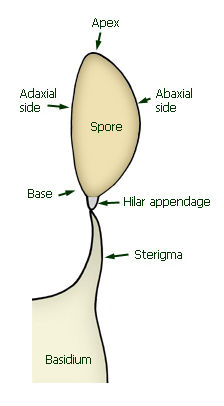
abaxial
= in reference to the sides of a spore, that opposite the adaxial side,
facing away from the long axis of the basidium when the spore is attached to the sterigma. See
adaxial.
aculeate
= prickly, with narrow spines. Compare echinate.
acyanophilous
= not cyanophilous.
adaxial
= in reference
to the sides of a spore, in side view, that on which the hilar appendage is attached, facing the long axis
of the basidium when the spore is attached to the sterigma. See abaxial.
adnate
= in reference
to the attachment of lamellae to the stipe apex, broadly attached.
adnexed
= in reference
to the attachment of lamellae to the stipe apex, narrowly attached.
agaric
= a macrofungus with lamellae. Often restricted to soft-fleshed macrofungi, but in FunKey encompassing all lamellate macrofungi. Adj. agaricoid. See also mushroom and toadstool.
allantoid
= sausage-shaped,
concave on the adaxial side, and much longer than wide.
amygdaliform
= almond-shaped,
with the abaxial side more deeply convex than the adaxial.
amyloid
= of spores or hyphae, reacting in Melzer’s reagent to form a bluish or
violet- to blackish blue colour. See dextrinoid and non-amyloid.
anamorph
= a state of a fungus producing asexual spores, or that is sterile. Compare teleomorph.
annulus
= membranous, flaring remains of the partial veil on the stipe. Colloquially
known as a ring. Compare ring zone.
apical
= at the apex (the top or tip).
apiculus
= see hilar
appendage.
appendiculate
= with scales or fibres hanging from the edge, usually in reference to the pileus.
appressed
= of fibres or scales, pressed flat against the underlying tissue.
arachnoid
= of the partial veil, cobwebby.
arboriform skeletal hyphae
= binding hyphae with an unbranched basal portion.
arcuate
= of lamellae in side view, arched, and consequently decurrent on the stipe apex.
areolate
= cracked in all directions, producing small blocks interspersed by cracks, like the dried-out
base of a clay pan.
atomate
= of a smooth surface, through optical illusion appearing to contain fine shining particles.
autodigestion
= secretion of enzymes by an organism, leading to the break-down of its own tissues. See
deliquescent.
bacilliform
= very long and narrow. When applied to spores, with Q > 3.00.
basal
= at the base or bottom.
basal tomentum
= fibres or hairs on the base of the stipe. Sometimes referred to as the basal mycelium,
which is more properly the mycelium from which the stipe arises.
basidiole
= immature basidium. These lack apical sterigmata, but otherwise
are similar in shape and size to mature basidia.
basidiome
= see fruit-body.
basidium
(pl. basidia) = the usually clavate elements in the hymenium that produce spores,
from apical sterigmata.
bilateral
= of the arrangement of hyphae in the lamellar trama, in cross-section with two lateral
strata in which hyphae extend at an acute angle from the line extending down the middle of the lamella from top to edge,
with each hypha of the lateral strata having the end near the mid-line closer to the top of the lamellae than the end at
the subhymenium. In a cross section of the lamella viewed with the edge at the bottom, the lateral strata of the trama form
an inverted V-shaped pattern. Also known as divergent. Compare inverse.
binding hyphae
= secondary hyphae that are thick-walled and highly branched. See arboriform skeletal
hyphae.
breadth
= of spores, the distance between the sides in face view.
broadly ellipsoid
= ellipsoid, but with the longer diameter not much greater than the shorter diameter.
When applied to spores, with Q = 1.15–1.30.
broom cell
= a cystidium or terminal element of the pileipellis with numerous apical protuberances
which may be short (Rotalis-type) or long (Siccus-type). Also called celles or
cystides en brosse (French).
caespitose
= growing in a dense cluster.
callus
= a term formerly used for types of germ pore where the wall at the apex is thinner
and not very truncate.
calyptra
= a partial envelope around the spore formed by the perispore, which is often
closely applied to the apex of the spore, and loosest around the exposed edge. Compare utriculate.
cap
= see pileus.
capitate
= at the apex with a distinct rounded head (caput), subtended by a narrower
segment (neck). Compare capitulate.
capitulate
= at the apex with a distinct but small rounded head (capitulum), subtended by
a narrower segment (neck). Compare capitate.
capitulum
= a small rounded head. Compare caput.
caput
= a rounded head. Compare capitulum.
carpophore
= see fruit-body.
caulocystidia
= cystidia (sterile elements) on the stipe.
celle en brosse
= see broom cell.
cellular
= of a tissue, comprised of more or less globose elements.
cheilocystidia
= cystidia (sterile elements) on the edge of lamella.
chrysocystidia
= cystidia (usually pleurocystidia but may be cheilocystidia)
that have an amorphous internal body that is bright yellow in alkali solutions (such as KOH) and also
becomes strongly coloured in stains such as Cotton Blue. Chrysocystidia are typically fusiform in shape,
with a narrow apical projection (mucro).
circumsessile
= of the volva, membranous and tightly adhering to the stipe base, with no free
rim at the upper edge.
citriniform
= see limoniform.
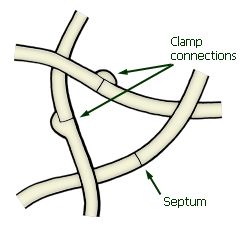
clamp connection
= a structure at the septum of a hypha, forming a roughly semi-circular
projection in side view.
clavate
= club-shaped, with the widest point towards the apex.
concave
= curved like the inside of a bowl.
conical
= cone-shaped, widest at the base, triangular and with an acute apex.
connate
= fused together. When applied to the habit of fruit-bodies, caespitose
and with stipes fused at the base.
context
= the interior flesh of the fruit-body. This term is applied at the macroscopic level.
The term trama is used at the microscopic level.
convergent
= see inverse.
convex
= curved like the outside of an upturned bowl.
corticioid
= of the hymenium of a resupinate fungus, more or less smooth (as in Corticium).
cortina
= an arachnoid (cobwebby) partial veil.
costate
= ribbed.
crenate
= scalloped, with a series of rounded projections.
crenulate
= finely crenate.
criniform stipe
= a sterile modification of the fruit-body where a rhizomorph-like stipe is topped
by a minute aborted pileus. In contrast to the normal stipe, growth is not geotropic.
cuspidate
= of the apex of the pileus, drawn out into a long point. Compare
papillate.
cuticle
= see pileipellis.
cutis
= a type of pileipellis, with the hyphae more or less repent (parallel to the
surface) ; usually arranged radially (parallellocutis), but sometimes not (mixtocutis).
cyanophilous
= of spores mounted in Cotton Blue, with the spore wall staining blue in contrast to
the interior of the spore, or with any ornamentation alone staining blue. Compare acyanophilous.
cylindrical
= of even diameter along the length. When applied to spores, with
Q = 2.0–3.0.
cystide en brosse
= broom cell.
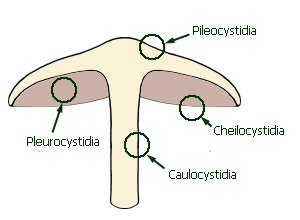
cystidium
(pl. cystidia) = a sterile element in the hymenium or pellis, differing
in size, shape and/or pigmentation from basidia and basidioles in the hymenium and from the basic
elements that make up the pellis. See Caulocystidia, Cheilocystidia, Pileocystidia and
Pleurocystidia.
cystoderm
= a type of pileipellis consisting of globose to ellipsoid elements in one layer
(monostratous, and here referred to as an epithelioid hymeniderm) or more than one layer (pluristratous,
and here referred to as an epithelium).
decurrent
= in reference to the attachment of lamellae to the stipe apex, broadly
attached and extending down the stipe, either because the lamellae are triangular in outline or because the
lower surface of the pileus is at an acute angle to the stipe (often then also with the pileus
uplifted).
decurrent tooth
= in reference to the attachment of lamellae to the stipe apex,
adnate with a small descending tooth on the lower edge at the point of attachment.
decurved
= of the edge of the pileus, bent downwards.
deliquescent
= having the lamella (and usually also pileus) tissue liquefy by
autodigestion (from secretion of enzymes by the organism itself).
dendrophysoid
= with tree-like branches.
dentate
= with tooth-like projections.
denticulate
= finely dentate.
depressed
= of the centre of the pileus, with a shallow or deep depression
(umbilicus).
descending
= of the lamellar trama hyphae, descending from the pileus trama to
the edge of the lamella, more or less at right angles to the edge of the lamella.
dextrinoid
= of spores or hyphae, reacting in Melzer’s reagent to form a
reddish brown to purplish brown colour. This reaction is also called pseudoamyloid. See
non-amyloid and amyloid.
digitate
= with finger-like projections.
dimitic
= of the trama, comprised of two types of hyphae, such as
generative and skeletal hyphae. See monomitic and trimitic.
divergent
= see bilateral.
diverticulate
= with protuberances that are neither short (nodulose) nor long
(digitate), but often irregularly shaped and further branched.
echinate
= with acute-tipped spines. Same as spinose.
echinulate
= with small, acute-tipped spines. Same as spinulose.
ectomycorrhiza
= a type of mycorrhiza where plant rootlets are surrounded
by a sheath of fungal hyphae, which do not penetrate into plant cells.
element
= an intercalary or terminal compartment of a hypha. Used in preference to
'cell' because the compartments are often multinucleate.
ellipsoid
= with a rounded outline, where the diameter along the main axis is longer
than the diameter along the axis at right-angles to this. When applied to spores, with
Q = 1.30–1.60.
elongate
= with an outline more elongate than ellipsoid, but less so than
cylindrical. When applied to spores, with Q = 1.60–2.00. In this context,
also called oblong.
end view
= of spores, viewed with the long axis pointing directly at the
observer. Same as polar view.
epithelium
= a type of pileipellis, consisting of inflated (globose to
broadly ellipsoid) elements, more than one layer deep (pluristratous), arranged in vertical or
irregular chains. Same as polycystoderm. Where the elements are one layer deep see
hymeniderm.
euhymeniderm
= see hymeniderm.
excentric
= off-centre.
face view
= of spores, the side-on view where the hilar appendage is at
the centre of one end of the spore. Also referred to as front view.
farinaceous
= of odour, resembling freshly ground meal; of a surface,
as if covered with flour. Also referred to as mealy.
fibrillose
= with a covering of silk-like fibres.
filiform
= very narrowly cylindrical.
fimbriate
= fringed, with fine projecting fibrils.
flesh
= see context.
floccose
= like the surface of cotton flannel, with interwoven fibres (the fibres are
shorter than when tomentose).
foveate
= pitted.
free
= in reference to the attachment of lamellae, not attached
to the stipe apex. See remote.
friable
= breaking up readily into small pieces.
front view
= of spores, see face view.
fruit-body
= the spore-producing structure of macrofungi. Other synonymous terms are
carpophore, sporophore, sporocarp and basidiome.
fugacious
= soon disappearing.
furfuraceous
= covered with fine particles, scurfy, like dandruff. Compare
granular and pruinose.
fusiform
= widest around the middle, narrower at the apex and base.
gelatinised
= of hyphae, in a gelatinous matrix; the gel either
secreted by the hyphae or formed from the break-down of hyphal walls.
generative hyphae
= the basic type of hypha; they are septate, often with clamp
connections, and usually thin-walled (sometimes thick-walled).
geotropic
= growing towards the ground; negatively geotropic is growing
away from the ground.
germ pore
= a differentiated area of the spore wall at or near the apex,
where all or some of the wall layers are interrupted or modified, so as to appear thinner
and/or paler.
gill
=
see lamella.
glabrous
= lacking fibres or hairs.
globose
= spherical, circular in cross-section, of even diameter.
When applied to spores, with Q = 0.95–1.05.
gloeosphex cystidium
= a cystidium with a characteristic narrow apex in
the shape of an hourglass, surrounded by a droplet, which may partially collapse or
disappear. The body of the cystidium can be clavate, fusiform or lageniform.
glutinous
= with a layer of thick slime. Compare viscid.
granular
= covered with fine particles, like grains of salt.
Compare furfuraceous and pruinose.
gregarious
= growing in a colony with many other fruit-bodies
of the same species.
hilar appendage
= the minute projection on a spore where attached
to the sterigma. Also called the apiculus.
hispid
= with erect hairs that are relatively long and somewhat
flexible. Compare pubescent, velutinous and villose.
hyaline
= colourless.
hygrophanous
= having a water-soaked appearance when wet and changing
colour on drying.
hydnoid
= of the hymenium, covering spines (as in Hydnum).
hymeniderm
= a type of pileipellis, consisting of erect hyphae
with terminal elements all originating at the same level. Terminal elements are typically
clavate (a euhymeniderm, resembling the palisade of basidia in a hymenium); but may be
fusiform or cylindrical (a trichohymeniderm) or globose to subglobose (an epithelioid
hymeniderm, monostratous cystoderm). Compare trichoderm.
hymenium
= the spore-bearing layer, consisting of basidia,
basidioles and sometimes cystidia, covering the surface and edge of
lamellae. Adj. hymenial.
hyphae
= the typically cylindrical elements that make up the
microscopic structure of fungi. In agarics the hyphae always have septa
(cross walls).
hyphal peg
= a bundle of 10–50 unbranched hyphae emerging from the
hymenium, projecting 25–250 µm from the surface of the lamella.
hyphal system
= the number of different types of hyphae in the
trama. See monomitic (one type), dimitic (two types) and
trimitic (three types).
hypoderm
= the lowest layer in a multi-layered pileipellis.
Also known as the subpellis. See mediopellis and suprapellis.
inamyloid
= non-amyloid.
infundibuliform
= funnel-shaped.
inrolled
= of the edge of the pileus, rolled inwards.
inserted
= see insititious.
insititious
= of the stipe base, arising directly from the substrate
(especially fallen leaves) without any basal mycelium. Also referred to as inserted.
intervenose
= with frequent cross-walls or cross-veins between
adjacent lamella and lamellulae.
interwoven
= of the arrangement of hyphae in the lamellar
trama, in cross section with the hyphae in all directions, not parallel.
Also called irregular.
inverse
= of the arrangement of hyphae in the lamellar
trama, in cross-section with two lateral strata in which hyphae extend at an
obtuse angle from the line extending down the middle of the lamella from top to
edge, with each hypha of the lateral strata having the end near the mid-line further
away from the top of the lamellae than the end at the subhymenium. In a cross
section of the lamella viewed with the edge at the bottom, the lateral strata of
the trama form a V-shaped pattern. Also known as convergent. Compare bilateral.
irregular
= see interwoven.
ixocutis
= a cutis made up of gelatinised hyphae.
KOH
= potassium hydroxide. A solution in water (commonly 3%) is used
in rehydrating and examining tissues. Also used for macrochemical and microchemical
reactions (such as to detect chrysocystidia).
labyrinthiform
= of the hymenium of a pileate or resupinate fungus, composed of plates in the form of a labyrinth (not radially arranged); or of the hymenium of a sequestrate (truffle-like) fungus, composed of irregularly arranged plates that in cross-section are in the form of a labyrinth. Compare lamellate, merulioid and tubular-poroid.
lacunose
= with a network of raised ridges, forming deep compartments.
lageniform
= widest towards the base and narrowly cylindrical above,
flask- or skittle-shaped. Compare clavate.
lamella
(pl. lamellae) = one of the thin plates that hang beneath
the pileus of agarics. The surface is covered by the hymenium. Colloquially known
as a gill.
lamellate
= of the hymenium, composed of radially-arranged lamellae. Compare labyrinthiform.
lamellula
(pl. lamellulae) = a short lamella that does not extend the
full distance between stipe (or point of attachment) and pileus edge.
lanceolate
= broadest around the middle and rather acutely tapered at the
apex and base. Compare ventricose.
lateral
= of the attachment of the stipe to the pileus, at the edge
latex
= milky or cloudy juice produced from when the fruit-body is cut.
Latex may be white or coloured.
lecythiform
= lageniform (widest below) with a capitate apex on a
short neck. Compare tibiform.
lignicolous
= growing on wood.
limoniform
= lemon-shaped, with a rounded protuberance at the apex. Also known as
citriniform.
macrofungi
= fungi that have macroscopically visible spore-producing structures
(fruit-bodies), such as mushrooms, puffballs or coral-fungi.
mamillate
= see papillate.
marginate
= of a lamella, with the edge differently coloured to the face.
mealy
= farinaceous.
mediopellis
= in a multilayered pileipellis, the layer between the surface
layer (suprapellis) and the hypoderm.
mediostratum
= a distinct layer in the middle of a cross-section of the lamellar trama.
Melzer’s reagent
= a solution containing iodine, in which spores or hyphae have either no reaction (inamyloid) or change colour to bluish black (amyloid) or reddish brown (dextrinoid).
merulioid
= of the hymenium, covering irregular, shallow ridges (as in Merulius). Compare labyrinthiform and lamellate.
metachromatic
= of spores mounted in Cresyl Blue, with the inner part of the spore
wall staining red, while the outer part and the spore contents are blue or purplish. Compare
orthochromatic.
metuloid
= a thick-walled cystidium with a capping of crystalline material at the apex.
moniliform
= cylindrical with regularly spaced constrictions. Compare strangulate.
monomitic
= of the trama, comprised of one type of hypha. See dimitic.
monostratous
= of the pileipellis, particularly an epithelium or
hymeniderm consisting of inflated elements, in one layer.
mucro
= a short projection at the apex of a cystidium or spore.
mucronate
= with a short projection (mucro) at the apex. Compare rostrate.
mushroom
= in the strict sense, a member of the genus Agaricus; but often used for any soft-fleshed macrofungus with a pileus and lamellae. In Europe, traditionally mushrooms were edible agarics and toadstools were those that were poisonous, but this usage is not appropriate in Australia, where the edibility or otherwise of many species is unknown. See also agaric.
mycelium
= a loose aggregation of vegetative hyphae.
mycorrhiza
= literally ‘fungus-root’, a relationship between plant and fungus where nutrients
are exchanged through specialized structures for mutual benefit of plant and fungus.
myxosporium
= see perispore.
nodulose
= of spores, in outline with relatively large and broad protuberances, as in
some species of Inocybe; of cystidia or hyphae, with short protuberances.
non-amyloid
= not reacting in Melzer’s reagent. See also amyloid and dextrinoid.
notched
= in reference to the attachment of lamellae to the stipe apex, broadly
attached but appearing as though a small piece of tissue has been removed at the lower edge of the lamellae
near the stipe.
oblong
= see elongate.
obovoid
= upside-down egg-shaped, with the apex broader than the base.
obpyriform
= upside-down pear-shaped, the base wider than the apex, more so than ovoid.
omphalinoid
= of agarics , similar in form to Omphalina, with small fruit-bodies
that have a central stipe, decurrent lamellae and no partial veil.
ornamentation
= projections from the spore surface.
orthochromatic
= of spores mounted in Cresyl Blue, with the spore wall and contents blue or
purplish, and no part staining red. Compare metachromatic.
ovoid
= egg-shaped, the base wider than the apex.
papillate
= with a relatively narrow projection (papilla), such as at the pileus apex.
Compare umbonate and cuspidate.
partial veil
= a veil initially covering the lamellae, connecting the pileus margin
with the stipe; upon rupturing usually forming an annulus or ring-zone on the stipe. Compare
universal veil.
pectinate
= a surface texture of short parallel ridges, like the teeth of a comb.
peel
= a strip of tissue from the surface of the stipe or pileus removed by lifting
up one end and peeling back from the underlying tissue.
pellis
= the surface layer/s of a tissue. See pileipellis, stipitipellis.
pellucid-striate
= see translucent-striate.
perispore
= a thin, transparent sheath around the spore. May be calyptrate or
utriculate. Also referred to as the myxosporium (which technically may have several layers, only
the outer of which may be a loose sheath).
phaseoliform
= bean-shaped, concave on the adaxial side, and not as long as allantoid
or as short as reniform.
pileipellis
= the surface layer/s of the pileus.
pileocystidia
= cystidia (sterile elements) that occur on the pileus surface.
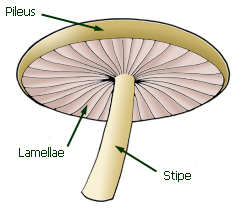
pileus
= the part of the agaric fruit-body below which are the lamellae.
Colloquially known as the cap. Adj. pileate = having a pileus.
plage
= a smooth or comparatively smooth area on the spore just above the hilar
appendage on the adaxial side, delimited from the rest of the spore surface by a distinct or indistinct
line. From the French word for beach. The plage may stain in Melzer's reagent, when it is called a hilar
or supra-hilar spot.
pleurocystidia
= cystidia (sterile elements) on the face of lamellae.
pleurotoid
= of agarics , similar in form to Pleurotus, with the
stipe absent, lateral or excentric.
plicate
= with sharp-edged folds, as in a pleated skirt.
pluristratous
= of the pileipellis, particularly an epithelium comprised of
inflated elements, in chains, more than one layer deep.
polar view
= of spores, see end view.
polycystoderm
= see epithelium.
polymorphic
= in reference to size classes of basidia, having more than
one size class.
poroid
= with rounded or angular pores (the openings to a tubular-poroid hymenium). Compare labyrinthiform and lamellate.
profile view
= of spores, see side view.
pruinose
= covered with very fine particles, as if dusted with flour. Compare
furfuraceous and granular.
pseudoamyloid
= see dextrinoid.
pseudorhiza
= a root-like underground portion of the stipe.
pseudosclerotium
= a sterile structure composed of soil particles or wood fibres bound
together by fungal hyphae. Compare sclerotium.
pseudostipe
= a dorsal extension of the pileus by which it is attached to the substrate.
pubescent
= with soft, short hairs. Compare hispid, velutinous and villose.
pulverulent
= covered in very fine particles, powdery.
punctate
= with very low projections, or dotted or spotted. Compare warty.
pyriform
= pear-shaped, with the apex broader than the base, more so than obovoid.
Q
=
the quotient of the length and width of spores.
radiate
= of the lamellar trama hyphae when seen in section, radially arranged in longitudinal section, more or less parallel to the edge of the lamellae.
regular
= of the arrangement of hyphae in the lamellar trama, in cross section
more or less parallel.
remote
= in reference to the attachment of lamellae, not attached to the stipe
apex, and with a gap between the stipe apex and the lamellae.
reniform
= of spores, kidney-shaped, concave on the adaxial side, and not much
longer than wide.
resupinate
= of a fruit-body, appressed to the substrate; without a pileus.
reticulate
= with a network of raised ridges.
rhizomorph
= a thin, ropy aggregation of hyphae arising at the stipe base. May be black
and shiny, resembling horse-hair.
rimose
= radially split or cracked. Compare areolate.
ring
= see annulus.
ring-zone
= remains of the partial veil on the stipe, forming a narrow or broad
band which does not appreciably flare out from the surface (as in an annulus). The ring-zone is
either the remnants of a collapsed cortina or else a membranous partial veil that has collapsed
on to the stipe or eroded so that all that remains is a narrow ridge.
rivulose
= with more or less radial wrinkles, branching like a river.
rostrate
= with a long, narrow projection at the apex. Compare mucronate.
Rotalis-type broom cell
= a broom cell with short, nodulose apical protuberances.
rugose
= wrinkled.
rugulose
= finely rugose.
saccate
= of the volva, sack-like.
saprotroph
= organism gaining nutrients from the breakdown of dead organic matter, such as
leaves, wood or dung.
sarcodimitic
= with two distinct types of hyphae in the trama, one very broad, fusiform and
slightly to distinctly thick-walled, and the other very narrow, usually branched, and wrapped around the
broad hyphae.
scalp
= a thin section from the surface of the pileus cut parallel to the surface.
sclerotium
= a sterile mass of hyphae, produced in the substrate. Compare
pseudosclerotium.
secondary hyphae
= hyphae other than the generative hyphae, i. e. binding,
skeletal or skeleto-ligative hyphae.
section
= a taxonomic subdivision within a genus, below the rank of subgenus.
septum
(pl. septa) = an internal cross wall, of a hypha or spore.
Adj. septate.
sequestrate
= with the hymenium hidden within the fruit-body, and not
exposed at maturity, as in truffles.
serrate
= with projections like the teeth of a saw.
serrulate
= finely serrate.
sessile
= without a stipe.
Siccus-type broom cell
= a broom cell with long, digitate apical protuberances.
side view
= of spores, the side-on view where the hilar appendage is visible at
the base of the spore, to one side. Also referred to as profile view.
sinuate
= in reference to the attachment of lamellae to the stipe apex, with
the lamellae edge having an asymmetrical S-shaped curve near the stipe; the edge ascending towards
the stipe but near the attachment with a small descent.
sinuous
= with a wavy outline.
skeletal hyphae
= secondary hyphae that are thick-walled, aseptate and
unbranched, or with few, non-tapered branches. See arboriform skeletal hyphae.
skeleto-ligative hyphae
= secondary hyphae that are thick-walled, aseptate and with
fine, tapering side branches, which may be further branched. There are usually several side
branches, one of which is directed backwards at the base and another forwards near the apex
of the main axis.
solitary
= growing alone.
sphaeropedunculate
= globose or subglobose, with a narrow, cylindrical basal portion.
spinose
= with acute-tipped spines. Same as echinate.
spinulose
= with small, acute-tipped spines. Same as echinulate.
spore
= the reproductive propagule of fungi. In agarics, produced by basidia
and very small (mostly in the range 5 to 15 micrometres) and almost always one-celled.
spore deposit
= spore print.
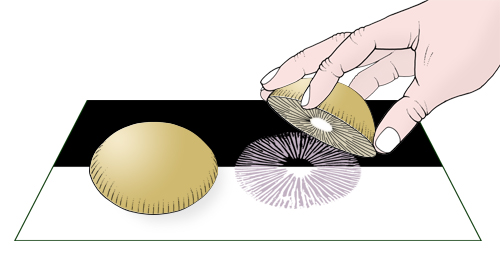
spore print
= a deposit of spores, such as produced when the pileus is detached from
the stipe and placed with the lamellae downwards on a piece of paper for some hours, or as can be
observed in the field when spores have fallen from one pileus onto another below. Also known as a
spore deposit.
sporocarp
= see fruit-body.
sporophore
= see fruit-body.
squamose
= scaly.
squamule
= a small scale. Adj. squamulose.
squarrose
= scaly, with erect tips.
squarrulose
= finely squarrose.
squash preparation
= of a sample prepared for microscopic examination, squashed by
judicious application of pressure to the cover slip, as by tapping with a needle.
stalk
= see stipe.
stellate
= star-shaped in outline.
stem
= see stipe.
sterigma
(pl. sterigmata) = small apical projection at the apex of basidia on which
a spore is borne. There are usually four, but there may be more or less.
stipe
= the support for the pileus. Colloquially known as the stem or stalk. Adj. stipitate = having a stipe.
stipitipellis
= the surface layer/s of the stipe.
stirps
(pl. stirpes) = an informal taxonomic division within a genus, usually within a section.
strangulate
= with irregularly spaced constrictions. Compare moniliform.
striae
= fine stripes. Adj: striate. See translucent-striate.
strigose
= with long, stiff hairs.
subcellular
= of a tissue, comprised of subglobose to ellipsoid elements.
subclavate
= between cylindrical and clavate in shape, widest towards the apex
but not markedly.
subdecurrent
= in reference to the attachment of lamellae to the stipe apex,
slightly decurrent.
subgenus
= the first taxonomic subdivision within a genus.
subglobose
= in outline a little longer than wide. When applied to spores,
with Q = 1.05–1.15.
subhymenium
= in context of the lamella, the tissue between the hymenium
(layer of basidia) and the lamellar trama.
subpellis
= see hypoderm.
substrate
= the material (e. g. soil, humus, bark or wood) or surface from which
fruit-bodies grow.
sulcate
= with grooves or furrows, as in a ploughed field.
suprapellis
= the outer layer in a multi-layered pileipellis. See
mediopellis and hypoderm.
synonym
= a name of a taxon that is not the current name. In the lists of species on each taxon fact sheet, synonyms are placed after an equal sign (‘=’). Where the synonym has the same species name, but in a different genus, only the genus is mentioned. For example: ‘Lichenomphalia chromacea (= Omphalina, Phytoconis)’.
taxon
(pl. taxa) = a unit within a classification. Examples are species
and genus (pl. genera).
teleomorph
= a state of a fungus producing sexual spores. Compare anamorph.
tibiform
= lageniform (widest below) with a capitate apex
on a long and narrow neck. Compare lecythiform.
toadstool
= a poisonous agaric, as opposed to an edible one (i.e. a mushroom); this distinction is not appropriate in Australia, where the edibility or otherwise of many species is unknown. See also agaric.
tomentose
= like the surface of a woollen blanket, with interwoven fibres
(the fibres are longer than when floccose).
trama
= the internal tissue of a structure. This term is applied at the
microscopic level. See context. Adj. tramal.
translucent-striate
= in reference to the top view of the pileus, striate
by virtue of the tops of the lamellae being visible through the pileus flesh. Also referred to
as pellucid-striate.
trichoderm
= a type of pileipellis, consisting of erect hyphae with
terminal elements not all originating at the same level. Compare hymeniderm.
trichohymeniderm
= see hymeniderm.
trimitic
= of the trama, comprised of three types of hyphae, such
as generative, skeletal and binding hyphae. See monomitic and
dimitic.
tuberculate
= with tubercules. Same as warty.
tubercule
= a small rounded projection. Same as wart.
tubular-poroid
= of the hymenium, lining vertical tubes that open in rounded or angular pores. Compare labyrinthiform and lamellate.
umbilicate
= with an umbilicus.
umbilicus
= a deep, navel-like depression in a surface.
umbo
=
a rounded, boss-like projection.
umbonate
= with an umbo. Compare papillate.
universal veil
= a veil initially covering the whole fruit-body, often leaving
a basal volva and/or patches of tissue on the pileus surface. Compare partial veil.
utriculate
= a complete, loose envelope around the spore formed by the
perispore. Compare calyptrate.
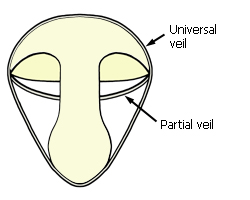
veil
= a membranous or cobwebby layer initially covering all or
part of the fruit-body. See partial veil and universal veil.
velutinous
= velvety, with erect hairs that are short and dense. Compare
hispid, pubescent and villose.
ventricose
= broadest around the middle. Same as fusiform. Compare
lanceolate.
verrucose
= with low, rounded projections. Same as warty.
verruculose
= finely verrucose.
villose
= with erect hairs that are relatively long and fine. Compare
hispid, pubescent and velutinous.
viscid
= with a thin layer of slime. Compare glutinous.
volva
= remains of the universal veil at the stipe base; may be
circumsessile, flaring or saccate, or consist of rows or zones of ridges
or scales, or powdery or membranous remnants.
warty
= with low, rounded projections. Same as verrucose and
tuberculate. Compare echinulate and punctate.
width
= of spores, the distance between the sides in side view.
top of page
Abbreviations
Colour charts
BFFRoyal Botanic Gardens Edinburgh (1969), Flora of British Fungi Colour Identification Chart. Her Majesty's Stationery Office, Edinburgh.
METHUENKornerup, A. & Wanscher, J.H. (1978), Methuen Handbook of Colour, 3rd edn. Methuen, London.
RAYNERRayner, R.W. (1970), A Mycological Colour Chart. Commonwealth Mycological Institute, Kew and British Mycological Society.
Herbaria
ADState Herbarium of South Australia, Adelaide
BRIQueensland Herbarium, Brisbane
CANBAustralian National Herbarium, Canberra
KHerbarium, Royal Botanic Gardens, Kew
MELNational Herbarium of Victoria, Melbourne
PERTHWestern Australian Herbarium, Perth
Other
ITSInternal Transcribed Spacer (of ribosomal DNA)
nLSUnuclear Large Subunit (of ribosomal DNA)
pl.plural
sens. lat.sensu lato (in a wide sense)
sens. strict.sensu stricto (in a narrow sense)
top of page
References for terminology
Cleménçon, H. (2004), Cytology and Plectology of the Hymenomycetes.
Bibliotheca Mycologica Volume 199. J. Cramer, Berlin.
Grgurinovic C. A. (1997b), Glossary, Fungi of Australia1A: 341–378.
Kirk, P.M., Cannon, P.F., Minter, D.W. & Staplers, J.A. (2008), Ainsworth & Bisby's Dictionary of the Fungi. 10th edn. CAB International, Wallingford.
Largent, D. L. (1986), How to Identify Mushrooms to Genus I: Macroscopic
Features, revised edn. Mad River Press: Eureka
Largent, D., Johnson, D. & Watling, R. (1977), How to Identify Mushrooms to Genus
III: Microscopic Features. Mad River Press: Eureka
Singer, R. (1986), The Agaricales in Modern Taxonomy, 4th edn. Koeltz Scientific
Books, Koenigstein.
Vellinga, E. C. (1988), Glossary, in C. Bas, T. W. Kuyper,
M. E. Noordeloos & E. C. Vellinga (eds), Flora Agaricina Neerlandica, Vol.1, 54–64.
A. A. Balkema, Rotterdam. [Useful illustrated glossary. ]
top of page
